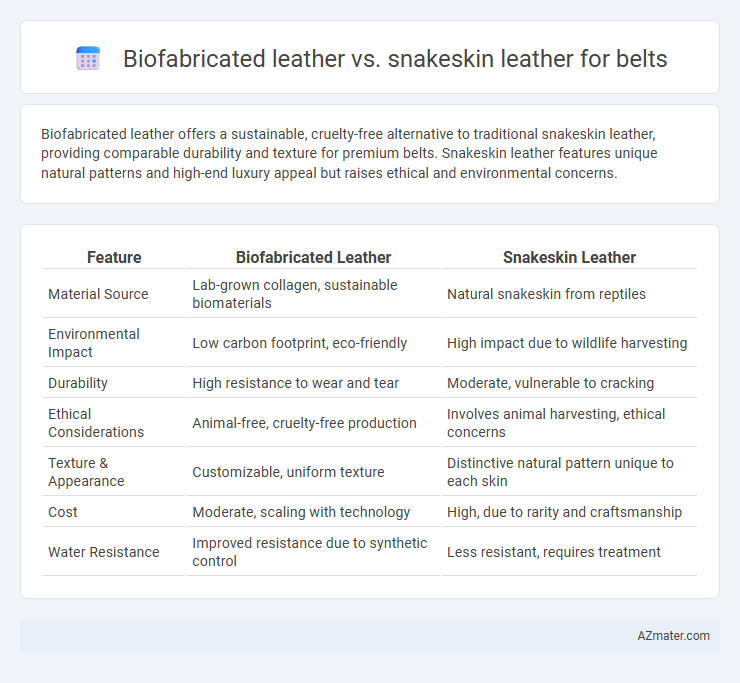Biofabricated leather offers a sustainable, cruelty-free alternative to traditional snakeskin leather, providing comparable durability and texture for premium belts. Snakeskin leather features unique natural patterns and high-end luxury appeal but raises ethical and environmental concerns.
Table of Comparison
| Feature | Biofabricated Leather | Snakeskin Leather |
|---|---|---|
| Material Source | Lab-grown collagen, sustainable biomaterials | Natural snakeskin from reptiles |
| Environmental Impact | Low carbon footprint, eco-friendly | High impact due to wildlife harvesting |
| Durability | High resistance to wear and tear | Moderate, vulnerable to cracking |
| Ethical Considerations | Animal-free, cruelty-free production | Involves animal harvesting, ethical concerns |
| Texture & Appearance | Customizable, uniform texture | Distinctive natural pattern unique to each skin |
| Cost | Moderate, scaling with technology | High, due to rarity and craftsmanship |
| Water Resistance | Improved resistance due to synthetic control | Less resistant, requires treatment |
Introduction to Biofabricated Leather and Snakeskin Leather
Biofabricated leather, created through sustainable biotechnology using cultured animal cells, offers an eco-friendly alternative to traditional leather with reduced environmental impact. Snakeskin leather, valued for its distinctive scale patterns and durability, is harvested from various snake species and prized in luxury fashion for unique texture and aesthetics. Both materials serve premium belt production but differ significantly in sourcing, ecological footprint, and textural properties.
Material Origins: How Each Leather is Produced
Biofabricated leather is produced through a sustainable process using cultured cells or plant-based materials that mimic the texture and durability of traditional leather without harming animals. In contrast, snakeskin leather is derived from the natural scales of snakes, requiring the harvesting and tanning of reptile skins, which raises ethical and environmental concerns. The biofabrication method offers a controlled, eco-friendly alternative while snakeskin leather relies on animal sourcing and conventional processing techniques.
Aesthetic Appeal: Texture and Visual Differences
Biofabricated leather offers a smooth, uniform texture with customizable finishes that can mimic various natural leathers, providing a consistent and modern aesthetic. Snakeskin leather features distinctive scale patterns and natural variations, delivering a unique, exotic look characterized by its glossy, textured surface. The visual contrast highlights biofabricated leather's sleek and versatile appearance, while snakeskin leather stands out with its intricate, organic texture and rich color depth.
Durability and Longevity Comparison
Biofabricated leather exhibits superior durability compared to snakeskin leather due to its engineered resistance to cracking, stretching, and moisture damage, ensuring a longer lifespan for belts. Snakeskin leather, while prized for its unique texture and aesthetic appeal, tends to be more fragile and prone to wear, especially in high-flex areas like belt straps. The advanced manufacturing processes behind biofabricated leather contribute to its enhanced longevity, making it a more practical choice for everyday use.
Environmental Impact and Sustainability Factors
Biofabricated leather for belts offers significant environmental benefits, including reduced water consumption and lower greenhouse gas emissions compared to traditional snakeskin leather production. Snakeskin leather harvesting often involves habitat disruption and ethical concerns related to wildlife exploitation, whereas biofabricated leather relies on lab-grown cells, minimizing ecological damage and promoting ethical sourcing. Sustainable biofabricated materials also enable scalable production with less chemical waste and land use, making them a more eco-conscious choice for fashion accessories like belts.
Ethical Considerations: Animal Welfare vs Biotechnology
Biofabricated leather for belts offers a cruelty-free alternative by eliminating the need for animal slaughter, aligning with ethical concerns surrounding animal welfare in snakeskin leather production. Snakeskin leather involves harvesting from live or wild-caught snakes, raising significant animal rights issues and ecological impacts. Biotechnology-based biofabrication leverages sustainable cell-culture techniques, reducing environmental harm while addressing growing consumer demand for ethical fashion materials.
Cost Analysis: Price Point and Market Value
Biofabricated leather for belts often carries a higher initial price point due to advanced production technologies and sustainable material sourcing, typically ranging from $100 to $200 per belt. In contrast, snakeskin leather belts, while variable in cost depending on species and quality, generally fall between $150 and $300, reflecting rarity and luxury market demand. Market value trends indicate biofabricated leather is gaining traction for eco-conscious consumers, potentially offering long-term cost efficiency through scalability and ethical appeal.
Maintenance and Care Requirements
Biofabricated leather offers low maintenance due to its resistance to water, stains, and fading, requiring only occasional cleaning with a damp cloth and mild soap. Snakeskin leather demands more careful care, including regular conditioning with specialized leather oils to prevent drying and cracking, along with protection from excessive moisture and sunlight. Choosing biofabricated leather belts reduces long-term upkeep, while snakeskin belts necessitate consistent, attentive care to maintain their texture and appearance.
Fashion Trends and Consumer Preferences
Biofabricated leather is gaining traction in fashion trends due to its sustainable appeal and cruelty-free production, attracting environmentally conscious consumers seeking stylish yet ethical belt options. Snakeskin leather remains popular for its distinctive texture and luxury status, favored by consumers who prioritize exotic aesthetics and traditional craftsmanship. Consumer preferences increasingly lean towards eco-friendly materials, positioning biofabricated leather as a forward-thinking alternative to the classic but less sustainable snakeskin leather in belt fashion.
Conclusion: Which Leather is Better for Belts?
Biofabricated leather offers superior sustainability and ethical benefits compared to snakeskin leather, which is often associated with environmental concerns and animal rights issues. Both materials provide durability and unique aesthetics, but biofabricated leather excels in customization, consistent quality, and reduced ecological footprint. For belts, biofabricated leather represents a more responsible and innovative choice without compromising style or function.

Infographic: Biofabricated leather vs Snakeskin leather for Belt
 azmater.com
azmater.com